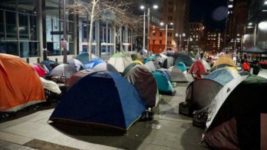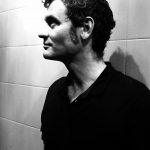Rough Sleeping Surges Nationwide, as Authorities Continue to Criminalise Homelessness

An extra 10,000 Australians are falling into homelessness every month, a new report by UNSW City Futures Research and Homelessness Australia reveals.
This post-pandemic surge includes a 22 percent rise in rough sleepers, or those forced to sleep out on the streets, over the three years to June 2024, which translates to a new monthly average of 4,636 extra people rough sleeping, while over the four years to June 2024, NSW has experienced a 51 percent rise in people sleeping outdoors.
Released on 9 December 2024, the Australian Homelessness Monitor 2024 outlines that “the deepening housing crisis is the major driver of worsening homelessness, with the number of people citing housing affordability stress as the main reason… having increased by 36 percent”. And it can be assumed that the dual cost-of-living crisis is too leading to more people falling through the cracks.
Based on the feedback from homelessness services and local government authorities, the report also underscores that there is a marked rise in employed people seeking crisis assistance over the growing lack of available and affordable permanent accommodation.
And despite this nation reeling in response to a crisis that’s been left to worsen over the past decade, Australian authorities are continuing to pass laws that criminalise those forced to sleep on the street, in a response that tends to imply that the those experiencing homelessness have done something wrong and then serves to punish them for the “criminal offence” of not being able to afford a home.
Rising number of elderly sleeping rough
“A key factor underlying the recent escalation in homelessness has been the remarkable surge in private sector rents affecting most parts of Australia since 2020,” the report states. “Over this period rents have risen at rates unseen since 2008.”
“Between March 2020 and June 2024, the median advertised weekly rent for all property types across all cities and regions rose from $413 to $624 – a 51 percent nominal increase, which exceeded the increase in general inflation over the same period by 29 percent,” the document adds.
The report further outlines that the reduction in the number of new social housing lettings annually over the last three decades, marks a 60 percent decline when considered proportionate to the population.
The period 1991 through to 2023 saw 52,000 new social housing lettings annually drop down to just 32,000 new dwellings appearing on the market each year.
Seventy seven percent of local homelessness providers are finding it “significantly harder to secure housing for clients” over the 12 months to June this year, than they had done the previous financial year.
And the fastest growing cohort in respect of homelessness are elderly civilians, with a 15 percent spike in 55- to 64-year-olds finding themselves with no fixed address over the last six years, and in terms of Australians 65 and over, there has been a dramatic 31 percent rise in those finding themselves without permanent accommodation.
“Funding for homelessness services has failed to rise to meet demand and the whole system is buckling under the pressure,” Homelessness Australia chief executive Kate Colvin said in a statement at the time of the report release.
“Governments need to take immediate action and deliver an emergency homelessness investment so that when people reach out for homelessness support there is someone there to help them.”
The death of public housing
At the end of last month, there were 62,592 families on the social housing waitlist in NSW. And that number nationwide translates to an estimated 175,000 households on the national social housing waitlist.
Established late last year, the Albanese government’s Housing Australia Future Fund announced its first round of building projects in September, which involves 13,700 new social and affordable housing units across the country, however only 4,220 of these new homes will be social housing.
Rather than focus on the provision of social housing, the Albanese government has instead spent the past year enacting laws to encourage the building of new accommodation specifically for the rental market, as well as laws to assist first home buyers in making their purchases.
Prior to the turn of the century, when talking about the provision of subsidised housing, the government would have been discussing public housing, but with the onset of the redevelopment of public housing sites that began in the western Sydney suburb of Minto in 2005, public housing sites have since been handed over to private developers.
This drive continues to this day, and it involves the redevelopment of public housing sites, as private developers then construct new residential blocks that consist of 70 percent private dwellings and 30 percent social housing units.
The main criticism of this two-decade-old practice is that instead of building new housing for the 175,000 households on the social housing wait list, the government is tearing down old housing that could easily be done up for much cheaper, while new housing sites comprised of affordable housing could be built elsewhere.
The use of social housing to define these housing projects is a misnomer, as the term social housing actually incorporates both public housing, which is owned and managed by the government, as well as community housing that’s run by non-profit organisations.
So, when government is speaking about “social housing”, it is actually referring to community housing.
Criminalising the homeless
Vagrancy laws, or the offence of homelessness, were already operating in Britian at the time that it invaded this continent in the late 18th century. And soon after the establishment of the colonies of NSW and elsewhere, the authorities enacted vagrancy laws
The colony of NSW passed An Act for the Prevention of Vagrancy and for the Punishment of Idle and Disorderly Persons, Rogues and Vagabonds in 1835. These laws empowered authorities to imprison the jobless, sex workers, habitual drinkers and white people who associated with First Nations people, in order to police the convicts who’d been brought here, after they’d been set free.
These laws were replaced by the Vagrancy Act 1902 (NSW), and it was revoked when the Summary Offences Act 1970 (NSW) was enacted. That legislation contained offences that included those relating to public places, vagrancy and public assemblies. And while begging was decriminalised in 1979, many of the offspring of those laws now sit in the Summary Offences Act 1988 (NSW).
Indeed, Australian politicians periodically crack down on homeless people, despite the society they’re governing failing to incorporate these people into its broader housed community.
A recent example of this was when the Melbourne City Council attempted to ban rough sleeping in 2017, due to a homelessness camp then set up at Flinders Street Station.
While the NSW Berejiklian government too passed the Sydney Public Reserves (Public Safety) Bill 2017, which provided move on powers relating to the “unlawful occupation” of Crown land. And it was specifically passed to disburse the 60-odd rough sleepers continuing to camp at the Sydney 24-7 Street Kitchen and Safe Space on Gadigal land in the CBD’s Martin Place.
Despite the recent surge in rough sleeping, or perhaps specifically because of it, the City of Moreton Bay in Queensland a fortnight ago, imposed a blanket ban on homeless people sleeping in motor vehicles, as well as prohibiting rough sleepers from owning pets.
Moreton Bay mayor Peter Flannery told the ABC that he was establishing the prohibitions on Quandamooka Country, in an effort to end the “lenient” approach the coastal city has been taking to the homeless.
But to frame the city as being lenient when it was not issuing fines to people with nowhere to go, over sleeping in the shelter of a van or for having an animal companion, again suggests that people with no fixed address are somehow in the wrong, to the point that they warrant punishment.
“These dogs are now attacking each other because they’re unrestrained, they’re attacking people, they’re attacking other homeless people,” Flannery told the national public broadcaster.
“We’ve been a bit lenient, as we have with other camping in public places policies, but we’re getting to the point where the number of incidents is outweighing the benefits.”
The ABC states that the laws permit fines of up to $8,065 to be issued for such infringements. Yet, it might be helpful if someone were to point out to Flannery that these people can’t afford to pay their rent, let alone pay a fine related to the fact that society has left them with nowhere to stay.







